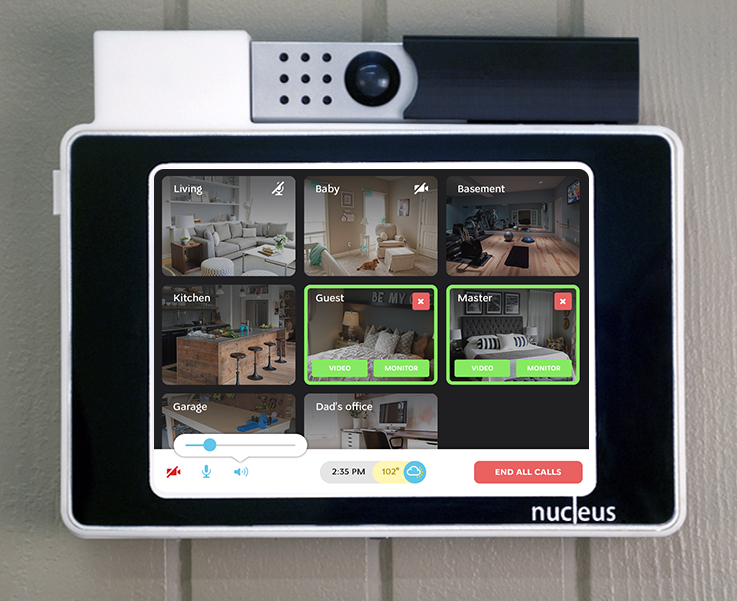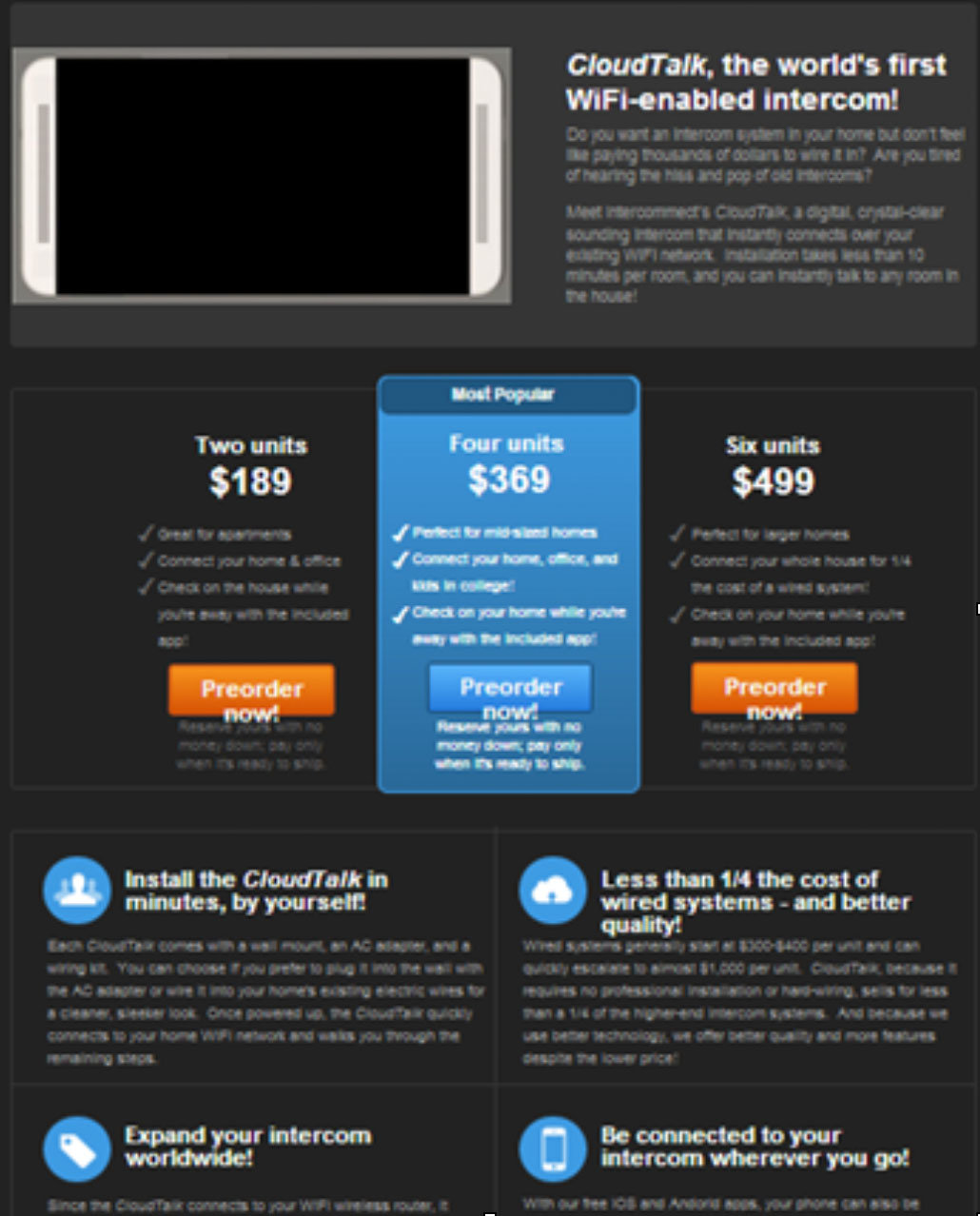Smart Home Intercom Startup Launched by Harvard Law Grad

 The following is a guest post by Jonathan Frankel of Nucleus. Nucleus is a wireless, Internet-connected intercom that lets you audio- or video- chat with any other Nucleus in the world – whether it’s in the next room or next country.
The following is a guest post by Jonathan Frankel of Nucleus. Nucleus is a wireless, Internet-connected intercom that lets you audio- or video- chat with any other Nucleus in the world – whether it’s in the next room or next country.
I am an unlikely candidate to be launching a hardware startup. While I do have a CS degree, the rest of my training – JD from Harvard Law, rabbinic ordination from Yeshiva University – does not exactly shout, “hardware!” Yet, after a brief sojourn as a management consultant, I find myself at the helm of Nucleus, a company building a smart, Internet-connected intercom system. These are the steps I used to launch Nucleus; hopefully it will demystify the process and allow you to found your own hardware startup as well.
Step 1: Solve a pain point
The idea for Nucleus was planted when my wife and I were renovating our home. With three little boys running around and demolishing our house, we wanted an intercom system to keep tabs on them. We asked the contractor for a quote, and he came back with a $3,500 estimate — for the same outdated system my parents had installed twenty years ago! I therefore went looking online for cheap alternatives, hoping to find an affordable wireless intercom system that I could install myself. None existed. I did hours of research, trying to save myself some money, but I simply could not find a quality intercom system that didn’t require expensive, professional installation.
Paying a high price for poor quality is painful. I launched Nucleus to solve that pain point. We quickly realized that by using WiFi, a touchscreen, and an HD camera, Nucleus can improve the user experience, add Internet connectivity, and still bring down the cost by an order of magnitude – and thereby remove the pain of purchasing an intercom.
If you have an idea for a new gadget, you have to be sure that consumers will desire it. If your no-name product is only incrementally better than what is already out there, convincing consumers to choose your product over the branded alternative will be a tough sell. But if you can solve their pain points in a way that no one else has successfully done, they will gladly shell out the money to buy your gadget.
Step 2: Research the market
You identified a pain point. Great! But how many people share it? This is where market research comes in. The goal of your research should be to determine the size of the total addressable market , and what percentage of that market you realistically believe you can capture.
Given the software background of many HackThings readers, this step becomes even more critical. When writing software, understanding your market deeply before writing code is important but not mission-critical; pivoting is a way of life for most software startups. But pivoting when you are manufacturing hardware is either extremely difficult or impossible, making the initial market research much more important.
Some ideas on how to determine the size of the total addressable market:
a) Ask industry professionals. I emailed one of the big intercom companies and asked them how large a market it is, and they were kind enough to direct me to the industry publication that compiles that data.
b) **Find sales numbers for largest players. ** You can often find this simply by Googling or reading 10-K’s. Where unavailable, you can often triangulate the data using other available numbers. For example, Nest doesn’t publish its sales figures, but it does publish the total number of kilowatts it has saved and the percent savings per household. Using the average home’s kilowatt usage, you can get a rough idea of sales figures.
c) **Build a model. ** Using public data — the Census is particularly helpful — you can begin to get an idea for how many houses, cars, bikes, pets, etc. there are in the country/state/city, etc. Use that data to construct a rough model of the market size.
Important note: when you do your market sizing, ask yourself if your innovation might change the overall size of the market. For example, see this excellent analysis showing how, in some markets, Uber is 120% larger than the historical taxi market. Similarly, our research showed that there is significant latent demand for an intercom system that is affordable and can be self-installed; using the historical intercom market would not paint the full picture.
When trying to determine what percentage of the market you will capture, a mix of quantitative and qualitative analysis is helpful. On the quantitative side, run surveys. They aren’t cheap (often $1-$3 per respondent), but they are a lot cheaper than developing a product that nobody wants. There are good tools available from SurveyMonkey, Instant.ly, and even Google Consumer Surveys.
Another great technique is throwing up a mock website and, using social media and Google ads, seeing if you can get anyone to “buy” your product.
Here is the mock site that landed me $4,000 in pre-orders with $150 in advertising. Yes, I made that mockup using MS Paint:

On the qualitative side, go out and interview your potential customers, distributors, and suppliers. Ask them what they currently use, what they like/dislike about it, and finally ask them if they would purchase your product. It is important to assure them that their honest feedback is appreciated, because otherwise most people’s bias is naturally towards saying “great idea!”
Step 3: Draft a Business Plan
If you’ve successfully identified a market niche that your product can fill, the next step is to draft a business plan. The business plan should be geared towards answering two questions:
a) How will I make Scrooge McDuck-style piles of money for myself and my investors?
b) If I make piles of money in this market, other people will want to as well — how will I stop my competitors from copying me?
These two questions should be answered in tandem. For example, if your plan is to prevent competitors from entering by being the low-price leader, you must figure out how to still make money at that lowest price point.
I highly recommend reading Columbia Business School professor Bruce Greenwald’s fantastic book on this topic, Competition Demystified.
Step 4: Build a hardware prototype
You may have noticed that we are four steps into launching your hardware startup and we haven’t yet spent a penny on actual hardware development. That is intentional. Unless you are filthy rich or love losing money, building hardware without first validating the market is not a wise proposition.
Now, how do you build hardware if you yourself are not an electrical or industrial engineer and can’t afford the hundreds of thousands of dollars it would take to hire full-time engineers or an engineering firm?
Easy — you build a cheap prototype and then go raise the money to build a proper one.
[Why not just find an electrical engineer that wants to join your startup and work for free/equity? Because they won’t. No matter how good of an idea you have, high-quality engineers have their pick of jobs; until you can show them that you have accomplished something — built a prototype, raised money, etc. — they won’t consider joining you. You need the engineers, but they don’t need you.]
How do you build a cheap prototype? Search LinkedIn and Coroflot for freelance industrial designers and/or electrical engineers near you. Students or recent grads are often willing to work for not much more than the cost of materials; they value the experience and opportunity to add to their portfolios.
Early 3D rendering of Nucleus wireless intercom from Likuma Labs:

Another good resource is to visit your local “maker space” and ask around to see if anyone is interested in the project. For example, here in Philadelphia we have NextFab. Using these techniques I was able to find the team at Likuma Labs. Since they had recently launched their rates were much more reasonable than a more established shop, and they did great work.
Step 5: Build the software
Now that your hardware development is underway, it’s time to start building your accompanying software.
This step is probably the one that comes most naturally to the HackThings audience. If you can build it yourself, please skip to the next step; otherwise, read on.
Finding good software engineers to join your company at this stage is almost as difficult as finding quality electrical engineers. However, it may be worth at least trying. Search LinkedIn, GitHub, Indeed, StackExchange,Gild, and Poacht for the skillset you are looking for. If you don’t know the skillset you are seeking, take a friend with a CS degree out for a beer and ask them. If you don’t have a single friend with a CS degree…well, I admire your gumption.
While this technique did eventually work for me (finally struck gold on Indeed), it took awhile. In the meantime, you are going to want to outsource the software development. The cheapest way of outsourcing is to use oDesk, Elance, or other freelancing sites. However, the quality is not consistent; I have a CS degree and still had trouble communicating what needed to be done. Rather, I highly recommend PickCrew, which curates talented developers and designers from around the world. Through PickCrew, I found Airnauts, who did a fantastic job of getting v1.0 of the software ready to ship.
Step 6: Raise money
Now that you validated your market and have a business plan, hardware prototype, working software, and hopefully the beginnings of a team, you are in an excellent position to go raise a small seed round. The money you raise can then be used to expand your team and, if necessary, to hire an engineering firm to design your product for manufacture.
A lot of ink has been spilled about the best way to raise a seed round. I recommend reading the following: Chris Dixon’s take, Gabriel Weinberg’s advice (and everything else on his blog), and these posts by Mark Suster.
Step 7: Market the heck out of your product
Ideally you would start marketing slightly before fundraising so you can point to some traction when pitching. You should at least be marketing continuously as you hone your prototype and move to market. The goal here is threefold: a) incorporate feedback from potential customers into the design process, b) find potential strategic partners (suppliers, manufacturers, etc.), and most importantly, c) build up an email list of interested customers.
There are various ways you can reach your audience: ads (expensive but they work), blogger outreach (check out Inkybee for researching blogger influence), aggregators (i.e. Reddit, ProductHunt), content marketing, and social media.
I want to talk a little about content marketing. You should have a discrete goal in mind when doing content marketing, and subtly alert the reader as to what it may be. For example, with this post, I was alerting you to the existence of Nucleus with the further goal of driving email signups on my website. If your goal is to raise money, find beta testers, employees, etc., then make sure that there are enough cues embedded in your content to alert any readers that are interested in those areas.
Regarding social media, there are many out there who are more expert than myself; go read their tips. However, one effective tool that I’ve found is sweepstakes. I embedded a widget (from ViralSweep) on my website and it has helped drive social conversions. [And yes, it is yet another place you can leave me your email address].
Steps 8 – ∞
As Nucleus progresses further, I hope to post with additional information about manufacturing, distribution, logistics, and other fun topics.
In the meantime, thanks for reading! Please feel free to reach out with any questions or comments. You can connect with me on Twitter and LinkedIn.